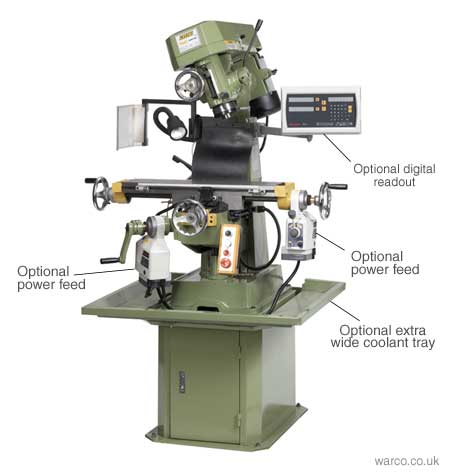Difference between revisions of "Equipment/WarcoMill"
RobCopcutt (Talk | contribs) (→Summary) |
RobCopcutt (Talk | contribs) (→Tips & Tricks) |
||
| Line 37: | Line 37: | ||
A climbing cut can put extra strain on the cutting tool. It produces a better finish so climbing cuts are good for light finishing cuts that leave a smooth finish. Use a conventional milling cut to get the part to approximately the final size. | A climbing cut can put extra strain on the cutting tool. It produces a better finish so climbing cuts are good for light finishing cuts that leave a smooth finish. Use a conventional milling cut to get the part to approximately the final size. | ||
| + | |||
| + | When drilling, start with a centre drill to make sure that the hole starts exactly centre. It is usually OK to drill to a depth of 3 to 4 diameters in a single pass. After that withdraw the drill ever diameter of cutting depth to clear the swarf. Use cutting fluid beyond a depth of about 2 diameters. Be aware that halving the diameter of a drill reduces its strength 8 fold. Much much less pressure is needed to drill small diameter holes. Use just enough pressure to create long curly chips. | ||
== Maintenance == | == Maintenance == | ||
Revision as of 01:44, 30 November 2013
Class Red equipment: Do not use without specific training.
(More about equipment classes)
Contents
Summary
(This machine has been purchased but not yet installed.)
The Warco mill can be used to machine objects from a wide range of materials. Training is required before members use the equipment because it is easy for users to damage themselves and the tool. The machine has a table 660 x 152mm that can move 37 cm in the X direction, 15 cm in the Y and 34 in the Z direction.
Owners
- Roger Smith
- Robert Copcutt
Health and Safety
- Power supply to be disconnected when changing tools.
- All cutting tools to be kept in their holders until they are required.
- Waste material/offcuts to be kept clear of work area.
- Equipment will be checked for defects before each use to minimise the risk of possible electrical faults or fire.
- Carbon Dioxide extinguisher to be available for any electrical fires
- Eye protection to be worn when using the equipment.
Training
Training and induction will start with a tour of the tool introducing all its parts. The following points will be covered.
- Keep hands well away from the spinning tools.
- Make sure there is no loose clothing or hair that can be caught in rotating parts.
- Take care to mount the work securely.
- Swarf has sharp edges so clean it away with a brush.
Instructions
Tips & Tricks
A climbing cut can put extra strain on the cutting tool. It produces a better finish so climbing cuts are good for light finishing cuts that leave a smooth finish. Use a conventional milling cut to get the part to approximately the final size.
When drilling, start with a centre drill to make sure that the hole starts exactly centre. It is usually OK to drill to a depth of 3 to 4 diameters in a single pass. After that withdraw the drill ever diameter of cutting depth to clear the swarf. Use cutting fluid beyond a depth of about 2 diameters. Be aware that halving the diameter of a drill reduces its strength 8 fold. Much much less pressure is needed to drill small diameter holes. Use just enough pressure to create long curly chips.
Maintenance
- Clean away all swarf at the end of a work session.
